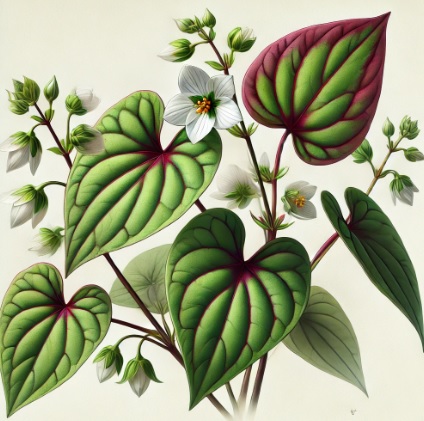The Saururaceae family is a small group of plants belonging to the order Piperales. It comprises around 4 genera and approximately 9 species, mainly distributed in temperate and tropical regions of the Northern Hemisphere, with a significant presence in East Asia and North America. The family is known for its aquatic or semi-aquatic plants, which often grow in wetlands or along stream banks.
General Description
The Saururaceae family is characterized by herbaceous, perennial plants, often found in moist environments such as marshes, riverbanks, and swamps. These plants typically feature elongated, often heart-shaped or ovate leaves and distinctive, spike-like inflorescences. Flowers are usually small and inconspicuous, typically unisexual and arranged in spikes or racemes, with an absence of petals.
The family’s most notable species, Saururus cernuus (commonly known as lizard's tail), is a popular aquatic plant recognized for its elongated, curled flower spike that resembles a lizard’s tail.
Chemical Composition
The plants in the Saururaceae family contain a variety of bioactive compounds, including flavonoids, alkaloids, and glycosides. Some species, such as Saururus cernuus, are known for their medicinal properties. For example, Saururus cernuus contains compounds with potential anti-inflammatory, antimicrobial, and diuretic effects. However, the full range of active compounds and their potential uses has yet to be fully explored in scientific studies.
Physical Properties
The plants in the Saururaceae family typically have soft, green stems and leaves, which often remain relatively low to the ground. Some species, such as Saururus cernuus, grow in wetlands and can extend their stems in aquatic environments. The flowers, which are small and often arranged on a long, slender spike, are not showy, but their unique structure makes them easily identifiable.
The plant’s ability to thrive in wetland environments allows it to play an important role in water filtration and ecosystem support in its native habitats.
Production Process
The plants in the Saururaceae family are typically propagated via seed or vegetative means. In some cases, these plants are cultivated for ornamental purposes in water gardens or as part of natural water filtration systems. The medicinal use of species like Saururus cernuus involves harvesting parts of the plant such as the rhizomes, stems, or leaves. These parts are usually processed through drying, boiling, or extraction to obtain beneficial compounds.
Applications
Medical
Some species of the Saururaceae family, particularly Saururus cernuus, have been used in traditional medicine for their diuretic, anti-inflammatory, and antimicrobial properties. Extracts from the plant have been used to treat ailments like urinary tract infections, rheumatism, and general inflammation. While there is some evidence supporting these uses, further scientific research is needed to confirm the therapeutic benefits.
Environmental
Saururaceae plants, especially Saururus cernuus, play a role in stabilizing wetland ecosystems. They help prevent soil erosion and filter water by absorbing excess nutrients and contaminants, improving water quality. These plants are also beneficial in wetlands restoration projects due to their ability to thrive in disturbed or degraded environments.
Ornamental
Species like Saururus cernuus are sometimes cultivated for ornamental purposes, particularly in water gardens, where their unique flower spikes and lush green foliage add visual interest. Their adaptability to wet conditions makes them an excellent choice for aquatic landscaping.
Environmental and Safety Considerations
The Saururaceae family’s plants are generally regarded as safe for use in traditional medicine, although some species may contain compounds that could cause mild irritation or allergic reactions in sensitive individuals. As these plants grow in wetland environments, they should be managed sustainably to prevent disruption to local ecosystems. The harvesting of these plants must be done in accordance with regulations to ensure that populations are not depleted.
INCI Functions
- Anti-inflammatory: Reduces inflammation in tissues.
- Antimicrobial: Inhibits the growth of microorganisms.
- Diuretic: Promotes the excretion of urine.
- Aquatic landscaping: Used in water gardens and as part of wetland restoration efforts.
In conclusion, the Saururaceae family is a small but ecologically significant group of plants, with some species offering potential medicinal and environmental benefits. Their role in wetland ecosystems, along with their ornamental value, makes them a unique and important part of the plant kingdom. However, more research is needed to fully understand their therapeutic potential.
![]() Saururaceae
Saururaceae 

